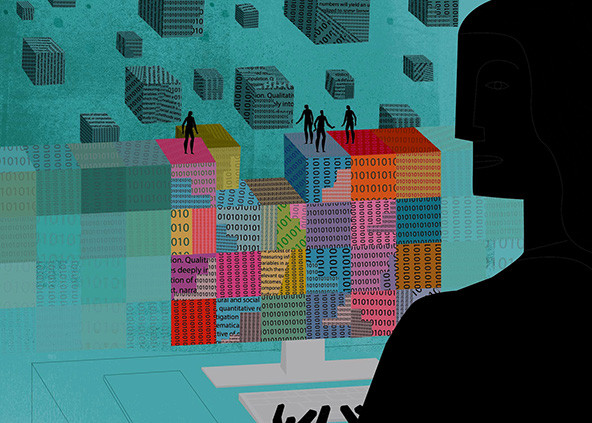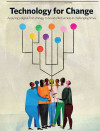 (Illustration by Mark McGinnis)
(Illustration by Mark McGinnis)

In 2012, Eric Dayton was a recent college graduate who faced a tech problem that would shape the course of his career. Experience Matters, a nonprofit based in Phoenix, Arizona, wanted him to integrate two isolated spreadsheets. One sheet had information about local volunteers, while the other had data on local community organizations that needed volunteers.
Technology for Change

Nonprofits need digital technology to meet today’s pressing challenges and serve their communities. This collection of articles explores the ways in which the social sector can and already is applying a digital-first strategy to boost its effectiveness. Sponsored by Salesforce
-
Grecian Urns and Trend Reports
-
Invading the Darkness of Child Sex Trafficking
-
From Measurement to Success
-
Technology Is Her Compass and Data Is Her Guide
-
Tech and Data That Inform, Inspire, and Involve
-
Data-Driven Connections for a Better World
-
Being a Digital-First Leader
-
Creating a Digital-First Strategy
-
Driving Social Change With Data
One challenge was that Dayton had studied international relations, not computer science. He didn’t code—his university in Botswana barely had the internet. Experience Matters also lacked a data team to help him. And he knew nothing about Salesforce, the software that the nonprofit wanted him to use to eliminate the tedious process of an employee scanning two disconnected spreadsheets in order to sync volunteers' skill sets with locals’ needs.
Like many people in their first job, Dayton learned as he went. He figured out a system to connect the groups of data. The pace of connections started to pick up: Not long after the new system went live, a former Intel engineer used it to connect to underserved kids at a local music school and he built them a sound studio. Other successful projects soon followed.
The experience showed Dayton the power of easy-to-use, scalable software to turn raw information into something that could make a difference in the real world. It also launched his career as a data manager and gave him insights into the haphazard approach to technology that many nonprofits employed and still use today. “We don’t have teams of engineers,” he said. “We don’t have teams of data scientists. We don’t even have teams of database administrators.”
Dayton’s own organization, the education nonprofit buildOn, is one exception. As the organization’s manager of digital infrastructure, he oversees a suite of data tools that is essential to running complex, collaborative, and geographically distributed tasks to construct schools in poverty-stricken countries around the world and run education and community service programs in the United States. In Malawi, Dayton said, buildOn might coordinate 15 to 20 simultaneous projects with numerous stakeholders across 100 different communities that have varying degrees of connectivity to the internet. And that’s just one country.
“If [people on a project] are traveling to and from those communities by motorbike, if they’re writing things down on a piece of paper and traveling back to the office and then entering data manually, a lot is going to get lost in translation,” he said in describing the challenges. One solution he is piloting is an app that will allow anyone working on a project to make updates from the field through text messaging. The app uses a chatbot-like interface with preprogrammed conversation prompts that cover an organization’s every activity and goal so a user can indicate, for example, if they've dug latrines or worked on a foundation that day. The app will also sync up with outside sources, such as the Malawi Ministry of Education’s database. The connection will allow for more surgical analyses, such as figuring out where a school is most urgently needed. This prepares buildOn to prioritize those communities and scale their work accordingly.
Breaking Down the Silos
Dayton said that his experience in Malawi and buildOn made clear how important it was to not just track data, but tie it all together. Otherwise organizations face the risks of “data silos”—a collection of information maintained by one part of an organization that is isolated from and not accessible from other parts of the organization.
When data is trapped in silos, people tend to work in silos, Dayton said. Effective collaboration requires a single source of truth and shared set of facts, and software like Salesforce can help create them, he has learned.
Much of his experience is echoed by other nonprofit professionals. For the second year in a row, Salesforce surveyed hundreds of nonprofits from around the world to assess what issues, trends, and opportunities they were experiencing. The resulting Nonprofit Trends Report (2nd edition, 2019-2020) concluded that “data is fast becoming the lifeblood of nonprofits as they seek to improve—and prove—impact.” Part of the focus on data is a concern with communication. With finely tuned data, a nonprofit can share information about outcomes and opportunities that might appeal to their supporters as a whole or subsets of them. Those targeted stories can lead to the donations that keep nonprofits running.
These increasingly sophisticated data systems reflect broader changes in the social sector to emphasize “people-centered services,” said Emily Putnam-Hornstein, an associate professor of social work at the University of Southern California and director of the data-integration platform Children’s Data Network. When these data systems were originally developed, they were developed around funding streams and a particular way of delivering a service, she said, an approach that created a “narrow vision” of who nonprofits were serving. That, in turn, blocked organizations from potentially making big advances with the help of knowledge that spanned more than a single perspective. Siloed information makes it difficult—if not impossible—to understand the “efficiencies that might be gained if we coordinated services differently,” she said.
Without a common place to collect information on their constituents, nonprofits cannot effectively connect with the communities they serve or their donors. They can’t easily reach new audiences, respond to new challenges, and capitalize on new opportunities. They become less agile. They may flounder rather than soar in the face of rapid change. Yes, 58 percent of nonprofits capture data on client or program participant satisfaction, the Salesforce report found, and another 51 percent measure donor satisfaction. But one in three nonprofits do not act on the information they collect, perhaps due to flawed data or lack of collective access, especially if the data is trapped on a shreadsheet or in a hand-written survey.
Turning On the Lights
It’s a lot harder to improve a program if you aren’t able to measure its success, notes the trends report. But how can we measure success in a sector where the bottom line is not purely financial? The answer is that many nonprofits do not. They just “bowl in the dark,” to borrow a phrase from Melinda Gates’ seminal 2010 TED Talk, “What Nonprofits Can Learn From Coca-Cola.”
The metaphor gave Dayton a useful perspective on his own work: “You hear the pins go down. You think, ‘Wow, I did an awesome job!’” he said. “But then the lights come on and only one pin has fallen.”
Without real-time data, there is no light, Gates said. It’s a lesson Coca-Cola knows better than most with its massive distribution network. If a store in Malawi runs out of the beverage, the company knows and can quickly ship more product to that location. Or if sales flag in San Francisco, Coke can identify the problem and try to address it.
Nonprofits should embrace a similar model, Dayton said, by adopting a theory of change that they constantly evaluate, with perpetual feedback loops built in at every stage and every level of a project. But what does that mean for an organization that is about more than moving a certain number of units of a particular product? For one, nonprofits need to collect performance data not only to measure the impact of a particular project, but also to drive continuous improvement within the organization itself. Jarrod Bell, CTO of Big Brothers Big Sisters of America, who spoke on a recent SSIR-Salesforce panel, said that such data can provide “not just a report of what’s happened, but also [the opportunity] to experiment around innovation, and actually tweak our programs based on the kind of feedback we see in the system.”
Getting at such valuable information is not always an easy task. Seventy-five percent of nonprofits surveyed said they struggled with how to measure and report data, according to the Salesforce survey. Another 47 percent said that capturing and managing accurate data on constituents is a challenging, complex undertaking that the report described as requiring new and deeper levels of data, goal setting, automated processes, and the rigorous tracking of results. For nonprofits to effectively create change, everyone in the organization needs to have access to information about the people they serve. Then they can begin to analyze performance metrics and overall impact.
To make matters even more complicated, many donors now expect this kind of data be delivered to them: Sixty-nine percent of nonprofits surveyed said that the demand for funding transparency has increased at least moderately over the past five years, up from 64 percent in 2018. Donors want to know their dollars are going directly to the people who need it most and not getting tied up in bureaucracy or helping to inflate an executive director’s salary.
Being thoroughly transparent also creates longer-lasting and richer connections between nonprofits and donors, according to the report, because nonprofits that do so also better understand their supporters and can clearly communicate with them regarding content, opportunities, and outcomes.
This is important because “emotions are just as powerful as the data,” said Becky Johnson, vice president of constituent experience and digital transformation at the American Heart Association (AHA), speaking on the SSIR-Salesforce nonprofit trends panel. “People don’t remember what you do—they remember how you made them feel.”
AHA’s recent fundraisers pulled in almost a billion dollars, which ensured the organization can conduct its life-saving research. Part of hitting that goal is understanding donors the same way businesses understand buyers of their products, said Johnson, who formerly worked for big brands like PepsiCo. Donors are like consumers, she said—they want emotional feedback when they part with their money; donors want to see who they helped and feel for them. “Show me a face,” she said. “Tell me a story.”
Stories of schools built and lives changed pour through buildOn’s social channels. It’s clear the nonprofit knows how to emotionally connect with its donor base. Another way it connects with its supporters is by directly involving them with its work. Through its Trek program, buildOn not only brings people together to raise and contribute $30,000 to cover the cost of building one school, it also involves them in the actual construction.
Dayton notes that Trek participants need to be able to raise the funds themselves. “We can’t possibly hire enough development staff to go in and manage every single one of those individual donors, so we empower those people to be fundraisers,” he said. “Then they engage their communities to do that work.”
Organizing the projects was another data-wrangling challenge that Dayton solved in 2014 with the Salesforce platform Classy, which enables peer-to-peer fundraising and crowdfunding. From 2013 to 2018, the number of Trek donors went from 500 to 15,000, a leap that Dayton said was largely made possible due to the technology.
“It’s all about scalability,” Dayton said. “You don’t need to staff to manage this—you can just let the tools do the work.”
Support SSIR’s coverage of cross-sector solutions to global challenges.
Help us further the reach of innovative ideas. Donate today.
Read more stories by Adrienne Day.

